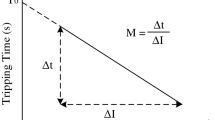Abstract
This paper proposes an adaptive optimum overcurrent protection for deregulated distribution networks containing parallel feeders. The proposed adaptive coordination eliminates the maloperation of conventional overcurrent protection under different fault scenarios. These scenarios take place when faults occur close to the end of the parallel feeders specially when faults are associated with significant fault resistances. Under these faults, the current at the backup relay is almost double that at the corresponding primary. Thus, adaptive pickup setting is recommended. However, this problem is complicated remarkably when distributed generation units feed the upstream source side faults or under the removal of the power source due to the interruption of a source side breaker. Simultaneously, the proposed coordination approach enhances the sensitivity and keeps on the optimum speed by automatically identifying the faulted zone. The faulted zone is identified by monitoring both the status concerning a single feeder or two parallel feeders in service and the faulted phase current direction of each pair of relays. Thus, a new fault direction identification method is presented. This method is based on comparing the angle of the post-fault current and that of the pre-fault current. Three optimization algorithms (genetic, harmony search, and water cycle algorithms) have competed to find the optimal settings of the installed overcurrent relays for each faulted zone. The reliability of the proposed method is examined as compared to conventional coordination concepts based on a detailed simulation of an actual 11-kV cascaded parallel series distribution feeder in the Egyptian distribution network. Sample results are examined.











Similar content being viewed by others
References
Kazemi S, Lehtonen M, Fotuhi-Firuzabad M (2012) Impact of fault diagnosis schemes on distribution system reliability. IEEE Trans Smart Grid 3(2):720–727
Elaziz AMA, Elsadd MA, Farrag SM (2017) Investigation of all possible optimal planning methods for primary distribution network. In: 2017 nineteenth international middle east power systems conference (MEPCON), Cairo, pp 521–526, 2017
Rajakovic N, Drca R, Arsenijevic N (2003) A methodology for optimal planning of capacitor installments in deregulated distribution networks. Eur Trans Electr Power 13:55–62
Elsadd MA, Elkalashy NI, Kawady TA, Taalab A-MI, Lehtonen Matti (2016) Incorporating earth fault location in management control scheme for distribution networks. IET Gen Transm Distrib 10(10):2389–2398
Elsadd M, Elkalashy N, Kawady T, Taalab A (2017) Earth fault location determination independent of fault impedance for distribution networks. Int Trans Electr Energy Syst 27(5):2389–2398
Tarhuni N, Elkalashy N, Kawady T, Lehtonen M (2015) Autonomous control strategy for fault management in distribution networks. J Elect Power Syst Res 121:252–259
Chaitanya BK, Yadav A, Pazoki M (2019) An intelligent detection of high-impedance faults for distribution lines integrated with distributed generators. IEEE Syst J Early Access 14(1):870–879
Chaitanya BK, Yadav A (2018) An intelligent fault detection and classification scheme for distribution lines integrated with distributed generators. Comp Elect Eng 69:28–40
Khalifa LS, Elsadd MA, El-Aal RAA, El-Makkawy SM (2018) Enhancing recloser-fuse coordination using distributed agents in deregulated distribution systems. In: 2018 twentieth international middle east power systems conference (MEPCON), 2018, pp 948–955
Yang H, Wen F, Ledwich G (2013) Optimal coordination of overcurrent relays in distribution systems with distributed generators based on differential evolution. Eur Trans Electr Power 23:1–12
The Electricity Training Association (2010) In: Power System Protection. New Delhi, India: Shankar’s Book Agency PVT. Ltd., First Indian Reprint, vol 2, 2010
Mason CR (1956) The art and science of protective relaying. Wiley, New York
Van Warrington RC (1969) Protective relays, their theory and practice. Wiley, New York
Urdaneta AJ, Nadira R, Perez LG (1988) Optimal coordination of directional overcurrent relays in interconnected power systems. IEEE Trans Power Deliv 3:903–911
Albasri FA, Alroomi AR, Talaq JH (2015) Optimal coordination of directional overcurrent relays using biogeography-based optimization algorithms. IEEE Trans Power Deliv 3:1810–1820
Damousis IG, Bakirtzis AG, Dokopoulos PS (2003) Network-constrained economic dispatch using real-coded genetic algorithm. IEEE Trans Power Syst 18(1):198–205
Azari A, Akhbari M (2014) Coordination of directional overcurrent relays in distribution systems based on network splitting. Eur Trans Electr Power 25:2310–2324
El-Khattam W, Sidhu TS (2008) Restoration of directional overcurrent relays coordination in distributed generation systems utilizing fault current limiter. IEEE Trans Power Deliv 23:576–585
El-Khattam W, Sidhu TS (2008) Resolving the impact of distributed renewable generation on directional overcurrent relay coordination: a case study. IET Renew Power Gener 3:415–425
Ibrahim DK, Abo El Zahab EE, Mostafa SA (2017) New coordination approach to minimize the number of re-adjusted relays when adding DGs in interconnected power systems with a minimum value of fault current limiter. Int J Electr Power Energy Syst 85:2017
Baran M, El-Markabi I (2004) Adaptive overcurrent protection for distribution feeders with distributed generators. In: Proceedings of IEEE power engineering society power systems conference and expositions, pp 715–719, 2004
Mahat P, Zhe C, Bak-Jensen B, Bak CL (2011) A simple adaptive overcurrent of distribution systems with distributed generation. IEEE Trans Smart Grid 2(3):428–437
Ahmed HO, Mohamed SH, Mohamad S (2015) Communication-based adaptive protection for distribution systems penetrated with distributed generators. Electr Power Comp Syst 43(5):556–565
Coffele F, Booth C, Dyśko A (2015) An adaptive overcurrent protection scheme for distribution networks. IEEE Trans Power Deliv 3(2):561–568
Perera N, Rajapakse AD, Buchholzer TE (2008) Isolation of faults in distribution networks with distributed generators. IEEE Trans Power Deliv 23:2347–2355
Megahed Ashraf I (2009) Adaptive protection for distribution systems with multiple distributed generations. Alex Eng J 48(6):663–672
Clark K, Miller NW, Sanchez-Gasca JJ (2008) Modeling of GE wind turbine-generators for grid studies, GE, Schenectady, NY, USA. www.pes-psrc.org/c/C17/GE%20WTG%20Modeling-v4%202.pdf
Pradhan AK, Routray A, Madhan Gudipalli S (2007) Fault direction estimation in radial distribution system using phase change in sequence current. IEEE Trans Power Deliv 22(4):2065–2071
Adly AR, Ali ZM, Abdel-hamed AM, Kotb SA, Abdel Mageed HM, Abdel Aleem SHE (2019) Enhancing the performance of directional relaying using a positive-sequence superimposed component. Electr Eng 102:591–609
Adly AR, Abdel Aleem SHE, Elsadd MA, Ali ZM (2020) Wavelet packet transform applied to a series-compensated line: a novel scheme for fault identification. Meas J Int Meas Confed 151:107156
Zahran AD, Elkalashy NI, Elsadd MA, Kawady TA, Taalab AI (2017) Improved ground distance protection for cascaded overhead-submarine cable transmission system. In: 2017 nineteenth international middle east power systems conference (MEPCON), Cairo, 2017, pp 778–758
Adly AR, Ali ZM, Elsadd MA, Abdel Mageed HM, Abdel Aleem SHE (2020) An integrated scheme for a directional relay in the presence of a series-compensated line. Elect Power Energy Syst 120:106–124
Elsadd MA, Yousef W, Abdelaziz AY (2020) New adaptive coordination approach between generator-transformer unit overal. Int J Electr Power Energy Syst 118:105788
Author information
Authors and Affiliations
Corresponding author
Additional information
Publisher's Note
Springer Nature remains neutral with regard to jurisdictional claims in published maps and institutional affiliations.
Appendix
Appendix
For the selected distribution system, the associated parameters for overhead and cable segments are as follows:
-
Positive-sequence resistances are 0.194 and 0.087 (Ω/km)
-
Zero sequence resistances are 0.3 and 0.2 (Ω/km)
-
Positive-sequence inductances 1.78 and 0.305 (mH/km)
-
Zero sequence inductances 6.1 and 1.75 (mH/km)
-
Positive-sequence capacitance 0.015 and 0.48 (μF/km)
-
Zero sequence capacitance 0.0049 and 0.206 (μF/km)
Associated parameters of the inserted DFIG machine are as follows:
-
Rated power: 3 × 0.45 MW
-
Stator rated voltage: 0.575 kV
-
Stator resistance: 0.023 p.u.
-
Rotor resistance: 0.016 p.u.
-
Stator reactance: 0.18 p.u.
-
Rotor reactance: 0.16 p.u.
-
Dc-link voltage: 1.15 kV
-
Dc-link capacitor: 10 mF
Associated parameters of the inserted PV- based DG are as follows:
-
Rated power: 0.5 MW
-
PV array delivering a maximum of 100 kW at 1000 W/m2 sun irradiance.
-
DC–DC boost converter to increase voltage from PV natural voltage (273 V DC at maximum power) to 500 V DC.
-
10-kvar capacitor bank to filter harmonics produced by VSC.
-
3-level 3-phase voltage source converter (VSC).
Rights and permissions
About this article
Cite this article
Elsadd, M.A., Kawady, T.A., Taalab, AM.I. et al. Adaptive optimum coordination of overcurrent relays for deregulated distribution system considering parallel feeders. Electr Eng 103, 1849–1867 (2021). https://doi.org/10.1007/s00202-020-01187-0
Received:
Accepted:
Published:
Issue Date:
DOI: https://doi.org/10.1007/s00202-020-01187-0




